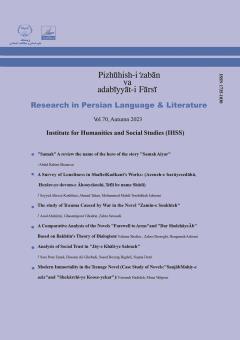One of the aspects of analysis in Shahnameh stories is the ability to interpret their myths. Among the stories of Shahnameh, Siavash's story is one of the examples that is appropriate to its previous and subsequent narrations in terms of narration and the connection of
More
One of the aspects of analysis in Shahnameh stories is the ability to interpret their myths. Among the stories of Shahnameh, Siavash's story is one of the examples that is appropriate to its previous and subsequent narrations in terms of narration and the connection of vertical and horizontal axes of the story. In this article, Siavash's story has been mythologically analyzed with a combined view and based on structuralist, mythological, and receiving theory approaches. The basis of this analysis is the ritual of familiarity and by using the view of Iliad, we have opened the ritual of entering the narration of Siavash. In this representation, the story from Siavash's birth to the end of Kaykhosrow's acting is considered as a unit and the actions of these two characters are considered to complement each other. According to the research findings, Siavash's rise and fall and then his sinking in Turan Zamin's graveyard is like sinking a seed in the soil; It is as if the story remains unfinished in this part, so much so that on the other hand, with the emergence of Kaykhosrow away from the eyes of Aghiar and his boasting in the same land of Turan, the story leads to self-sufficiency. Symbolic signs and evidence in the text of this story unit, such as: mountain, midwife, crossing the water, symbolic animal, test, etc., strengthen the concept of familiarity in it.
Manuscript profile


